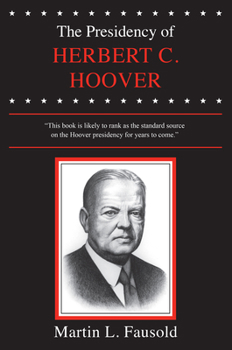The Presidency of Herbert Hoover
(Part of the American Presidency Series Series)
Select Format
Select Condition 
Book Overview
Few presidents have been subjected to such a wide range of interpretation as has Herbert Hoover, from hero to villain, from genius to na f. Fausold meets the daunting challenge of assessing the Hoover presidency by focusing on the to most basic questions: first, whether the Hoover presidency advanced the country toward the goals outlined in his Inaugural Address--justice, ordered liberty, equality of opportunity, individual initiative, freedom of opinion, integrity in government, peace, growth of religious spirit, and strengthening of the home--and, second, whether Hoover attacked the causes of the depression--international, cyclical, sectoral, fiscal, and monetary. Making use of extensive primary sources beyond the Hoover Library, Fausold argues that Herbert Hoover was what Walter Lippmann said a president should be, "a custodian of a nation's ideals," and that Hoover fought the causes of the depression with vigor and imagination. Nevertheless, on election day in 1932, Hoover was turned out of office in a landslide, carrying only six eastern states. From his defeat of Alfred E. Smith in 1928 to his trouncing by FDR four years later, Hoover's presidential years are detailed here: the stock-market crash, which happened eight months after Hoover took office; the ever-deepening depression; tariff legislation; Hoover's farm policy and foreign policy; and his pursuit of the twin goals of prosperity and freedom. This volume discusses in detail the relationship of the Hoover presidency to capital and labor, showing that Hoover's farm policies provide the best illustration of his corporatist formulas. Fausold reverses simplistic conclusions about the Stimson Doctrine, arguing that Hoover's Quaker pacifism, the Great Depression, and the forcefulness of Secretary of State Henry L. Stimson affected Hoover's foreign policy far less than has been presumed. Finally, Fausold details the disastrous events of the 1932 reelection campaign, punctuated by the march of the Bonus Army on Washington and culminating in Hoover's decisive defeat. Fausold views the Hoover presidency as the logical transition from progressivism to the New Deal, calling it both the last of the old and the first of the new presidencies. The important question about Hoover, Fausold argues, is not why the people refused to reelect him, but why the reversal of his nation's image of him was so overwhelming and has been so long-lasting. Despite three arguments in defense of the administration--that its goals and antidepression efforts were in many respects without precedent; that it was surely as much a failure of American capital as of presidential leadership; and that probably no American elected in 1928 could have survived the nation's greatest depression--Fausold points to two factors that were paramount in spelling the misfortunes of Hoover's presidency: his unalterable commitment to ordered freedom as a canopy for solutions to the depression, and his firm rejection of any kind of an accommodation with the New Deal.
Format:Paperback
Language:English
ISBN:0700603581
ISBN13:9780700603589
Release Date:January 1985
Publisher:University Press of Kansas
Length:304 Pages
Weight:0.10 lbs.
Dimensions:0.7" x 6.0" x 9.0"
Customer Reviews
1 rating
A Good Look at Hoover and His Tenure
Published by Thriftbooks.com User , 20 years ago
Part of what makes the University Press of Kansas' American Presidency Series anything remotely of interest or importance is their adherence to the topic at hand: the presidency. Herbert Hoover has a long and storied pre-White House career and that story has some relevance and bearing on his four years in Washington but it is a topic of focus for a different book. Martin Fausold points out that Hoover's four years as president speak volumes about the future course of the United States after March 1933 when Franklin Roosevelt took office. Hoover did not inherit the United States when it was on the verge of collapse nor was it at a peak. Black Tuesday, as Fausold illuminates, was a major turning point in the course of many levels of American movement: economic; social; cultural, and more. Most of this book is a detailed chronicle of the efforts Hoover used to extinguish the conflagration started by the October 1929 crash. Readers will note how small it seems to discuss a stock market crash caused by a drop of 375 or so points when in 2003, we have seen drops of two hundred points in a single day without much fervor or panic. Nonetheless, Fausold explains that the crash wa snot simply a one day event but a series of events throughout various sectors of the market that led to a mass sell off of stocks on Black Tuesday. Most interestlingly, however, Fausold explains that FDR, as early as 1929, made efforts to have his contentions known and demanded an audience with Hoover and policy officials. Fausold also destroys other authors' criticism of Hoover as a silent critic of the Federal Reserve system that practically fathered the stock market crash by pointing out that Hoover moved behind the scenes to inch toward reform because he did not want to destroy public confidence in the banking system. Revelations such as these make this work essential for anyone studying the Hoover presidency or with even a remote interest in any issue relating to Hoover, including the stock market crash.






